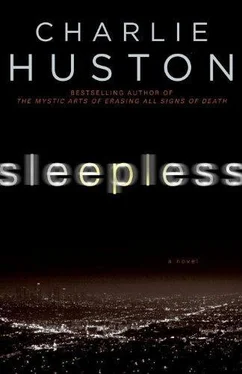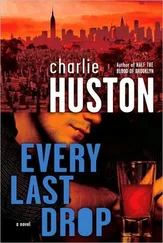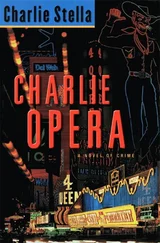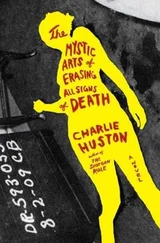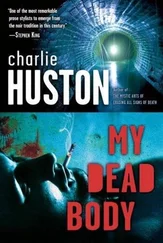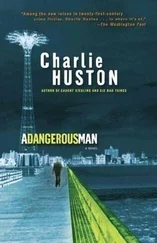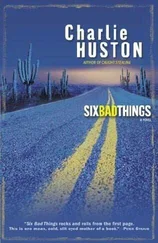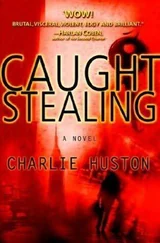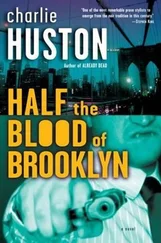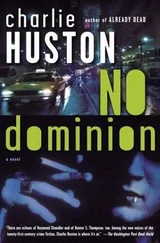No one opened fire, indicating either that they had not heard the sound or that it was too faint to allow for any accuracy. I made up for that faintness by yanking hard on the wire with a sweep of my arm that sent the Shuttle clattering onto the wood floor in the direction of the glass wall. A heartbeat’s pause, followed by a series of three well-spaced shots that traced the path of the computer, another pause, and a fourth shot placed just ahead of where the computer came to rest, another pause, and a fifth shot placed just behind the point where the computer began its journey. That final point was the one I’d occupied a scant second before.
But I was no longer there.
I was pinned in the corner of the room farthest from the front door. The jumble of my computer equipment, and the man who had been lookout, were between myself and the glass door. And I would have to climb over the length of the daybed if I wanted to reach the hallway to the back of the house or front door.
Cornered, if that is not redundant.
The shots had come from the battle-scarred side of the room. In such tight quarters his flash suppressor had done little to hide his position. Irrelevant, as I’d not had a gun in my hand with which to return fire. And he’d shifted yet again, in any case. Still, it seemed clear he was covering the living area and at least half the dining area. The last shot he’d fired had punched a hole in the thick glass wall. I mentally drew a line from that point to where he’d been when he pulled the trigger. The remaining man would be covering the other half of the dining area and the kitchen. And he would be doing so from a point just beyond where that last round had struck the glass.
Of course, I couldn’t be certain of any of this. I’d been tortured for hours. The wounds inflicted on me were still causing extreme pain. I’d been deprived of oxygen, and I’d lost blood. The room was dark and littered with objects and the remains of the Sui table. The two men I’d disabled were not by any means crippled and would likely be reentering the fray. My circumstances were dire and I was beyond desperate. My strategic evaluations had to be considered questionable, at best.
Thank God I had a winged cat taxidermy sculpture in my hands.
The artist who created the winged cat had been amused when I told her why I wanted one of some girth. She’d embraced the concept, along with the various custom features I’d requested. She told me she “enjoyed the James Bond irony.” I didn’t tell her that there was nothing ironic about the piece at all. To my sensibility, a dead cat with crow’s wings stitched to its back and a rocket pistol concealed in its hollow carcass was a grim foreshadow of what humanity had in store for itself.
To be clear, what was inside the winged cat was not an actual rocket pistol. It was, in fact, a Lund and Company Variable Velocity Weapons System. The “rocket” nomenclature was popular among bloggers with a fascination for fanciful weapons technology but little understanding of actual weapons. A VVW was essentially a self-contained launch system for both lethal and nonlethal projectiles. Buttons on the side of the gun determined how much fuel would be released into the combustion chamber behind the projectile when the trigger was pulled. It did not at all fire rockets, which are self-propelled. Rather, a controlled explosion, localized within the weapon, created a preselected muzzle velocity that could be changed from round to round. Designed for use in combat environments where civilians and hostiles mixed and were difficult to differentiate between, only a handful of VVW prototypes were ever produced. When I’d heard that one had come on the market a year prior, I’d spent a foolish amount of money to own it. It came with only a handful of the specialized ammunition and two refills of the fuel. Unable to help myself, I’d test-fired half the rounds. Loaded with rubber bullets it was combat-effective nonlethal as close as five meters. Loaded with full metal jacket it was lethal to as far as a thousand meters, though not at all accurate to even a tenth of that range. Multiple vents kept muzzle flash all but nonexistent and minimized sound. Because the amount of propellant was not dictated by the size of the round, a small bullet that loses little of its energy to air resistance could be fired at muzzle velocities generally reserved for high-caliber rifles. Set to red, the VVW can fire a.22-caliber armor-piercing round at one thousand meters per second. Comparable to a.300 Winchester Magnum round fired from an Accuracy International AWM sniper rifle.
I’d placed it inside the winged cat, loaded and primed, the red button depressed. When I slipped my hand into the belly of the cat and pulled the weapon free, I didn’t bother to change the setting in favor of the orange, yellow, or green buttons. My mood quite suited red.
On my belly, in my corner, I aimed under the couch at an angle, using the sound of a man gargling his own blood as a guide. I pulled the trigger, there was a slight flicker under the couch, as if a cap pistol had been fired, a sound like two overstuffed feather pillows being plumped against each other, and an almost instantaneous human grunt, followed by another distinct sound, this one as if a large and very wet paintbrush had been vigorously shaken at a wall.
Despite the vents, the recoil was tremendous. It was just as well my wrists were still bound and I was forced to use a two-hand grip.
Fire was being returned from the battle-scarred man’s side of the room, but with less consideration for decorum this time. I put a stop to this sloppy behavior before it could reach the point of general mayhem. There were ample muzzle flashes. I could see them clearly from the point I’d rolled to after firing my first shot. I took a bead on the ghost of one of the flashes, made a slight adjustment to the right, following the trail he was leaving as he moved and fired, moved and fired, and pulled the trigger again.
Less splatter this time, and an echo of broken crockery. The bullet must have pierced the body armor under his light jacket and struck the inner surface of a ceramic back plate, the bullet and plate both shattering on impact.
There was a respite of silence. Just a faint burble as the last bit of pressure in the battle-scarred man’s circulatory system pumped a few milliliters of blood from the tiny wound that would be in his torso. He’d probably not lose much blood from such a small wound as the one the.22 would leave. But even if it hadn’t fragmented when it hit the plate, the static shock from a bullet traveling at that velocity had no doubt killed him before he dropped.
On red, the VVW would fire only four rounds. Even if I had been tempted by dialing down to gain a few more shots, the symmetry of four men and four projectiles would have stopped me.
The silence wore on the man who had been lookout. He snapped a quick rhythm with his fingers, attempting to strategize. Before the man I’d stabbed in the foot could answer him, I did. The pillow sound again, splatter of paint, and the sharp tink of a crack appearing suddenly in a cold glass when something hot is poured inside. I could only hope that the bullet had expended most of its energy passing through its target and the glass and that it would drop harmlessly to some empty spot in the basin.
The last of them was still behind the kitchen island. One of his socks was no longer white. When I approached, he rose with his knife in one hand and the shears in the other. I ended any suspense by placing the last round in the middle of his chest.
I set the VVW on the island, picked up the bloody poultry shears from where they’d fallen, angled the blades between my wrists, and clipped the wires that bound them. Setting the shears aside, I walked down the hallway to the master bedroom and into the bathroom. In my first-aid cupboard I found gauze bandages, silver sulfadiazine, scissors, tape, an IV needle and hose, and two bags of saline fluid. Standing at the sink, I began using gauze pads to blot pus and blood from the insides and backs of my legs. The pain was intense, largely focused at the edges of the wounds where the burns were only second degree. The nerves at the hearts of the worst of the burns were entirely dead. Still, I’d need to salve and bandage them to stave off infection. And I’d need to rehydrate. And there was other business that needed taking care of.
Читать дальше
